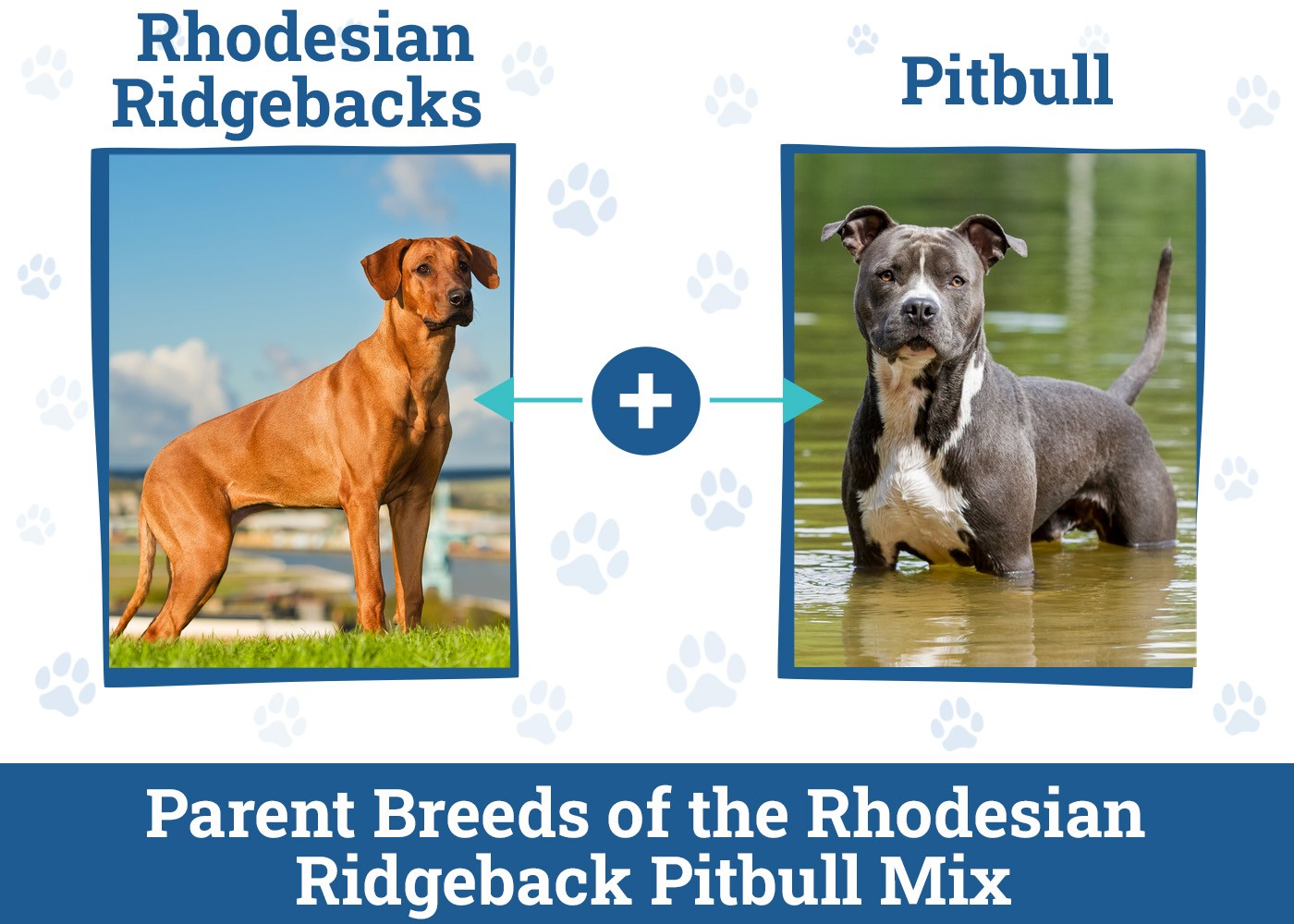
The Blue Rhodesian Ridgeback Pitbull mix represents a unique designer crossbreed combining the strength and loyalty of the Rhodesian Ridgeback with the intelligence and determination of the Pitbull. This rare color variation features a distinctive blue-gray coat, setting it apart from typical wheaten or brindle specimens. While inheriting the muscular build and protective nature of both parent breeds, these dogs typically stand 24-27 inches tall and weigh 70-85 pounds. Despite their imposing appearance, well-socialized Blue Rhodesian Ridgeback Pitbull mixes are known for their affectionate temperament and unwavering loyalty, making them excellent companions for experienced dog owners.
Blue Rhodesian Ridgeback Pitbull Mix
Physical Characteristics
The blue coat coloring in Rhodesian Ridgeback Pitbull mixes comes from the Pitbull parent's genetics. The blue coloration appears as a grayish or silver-blue hue and is relatively rare in this mix. These dogs typically maintain the muscular build and height of 24-27 inches characteristic of the breed mix, but with the distinctive blue coat variation. The blue coloring can range from light silver-blue to deeper steel blue tones, often with white markings on the chest and paws.
Care Requirements for Blue Coat
The blue coat requires specific grooming attention to maintain its distinctive color and prevent skin issues common in blue-coated dogs. Color dilution alopecia is more prevalent in dogs with blue coats, requiring regular monitoring of the skin and coat condition. Weekly brushing with appropriate tools designed for short coats helps distribute natural oils and maintain the coat's blue sheen. The blue coloring may fade with sun exposure, so limiting extended sun exposure helps preserve the coat's vibrant blue tone.
Physical Characteristics and Appearance
Size and Build
The Rhodesian Ridgeback Pitbull mix exhibits a powerful and athletic physique, standing 24-27 inches tall and weighing between 70-85 pounds. Males tend to be larger, reaching up to 85 pounds, while females typically weigh around 70 pounds. Their deep chest and well-defined musculature reflect the strength inherited from both parent breeds.
Distinctive Features
While the previous sections covered the blue coat variation, this section focuses on other key physical traits. The mix typically displays a short, glossy coat that can come in various colors including white, black, brown, red, and gold. A notable feature is the potential inheritance of the Ridgeback's characteristic ridge - a strip of backward-growing hair along the spine. Their head structure usually combines the Pitbull's broad skull with the Ridgeback's athletic facial features, resulting in a strong but refined appearance. The ears can either stand erect or fold over, depending on which parent's genes are dominant.
Training and Exercise Requirements
Specialized Training Methods
While the previous sections covered general physical traits, this section focuses on specific training approaches. The Rhodesian Ridgeback Pitbull mix requires consistent, firm training starting from puppyhood. Positive reinforcement techniques work best, as both parent breeds respond well to rewards-based training. Obedience classes are highly recommended to help channel their intelligence and drive. The mix needs clear boundaries and commands, with early socialization being crucial to prevent potential aggression issues. Training sessions should be kept engaging and varied to maintain their interest, utilizing their natural intelligence and eagerness to please.
Physical Activity Needs
These dogs require substantial daily exercise, typically around 2 hours split between multiple sessions. High-intensity activities like hiking, running, and agility training are ideal for meeting their exercise requirements. Their endurance levels make them excellent partners for active pursuits, while mental stimulation through puzzle toys and training exercises helps prevent destructive behaviors. A fenced yard is essential as they have high prey drive and may chase smaller animals. Without adequate exercise, they can develop problematic behaviors due to pent-up energy. The mix excels in dog sports and agility competitions, which provide both physical exercise and mental challenges.
Blue Rhodesian Ridgeback Pitbull Mix Health Considerations
Specific Health Issues Related to Blue Coat
While previous sections covered general health concerns, this section focuses specifically on health issues affecting blue-coated variants. According to research, the blue coat coloring makes these dogs more susceptible to Color Dilution Alopecia (CDA), a condition causing hair thinning and skin problems. The condition typically appears between 6 months to 3 years of age, requiring regular veterinary monitoring. Blue-coated dogs may also experience increased sensitivity to sunlight and higher rates of skin allergies compared to other coat colors.
Preventive Care for Blue Coat Variants
The blue coat requires specialized preventive care beyond standard health maintenance. Owners should implement regular skin examinations to detect early signs of CDA or other coat-related issues. A diet rich in omega-3 fatty acids and vitamin E helps maintain coat health and reduce skin inflammation. UV-protective clothing or limited sun exposure during peak hours helps prevent sunburn and skin damage. Regular veterinary check-ups should include specific attention to coat and skin health, with early intervention for any developing conditions. Maintaining proper humidity levels indoors can also help prevent skin dryness common in blue-coated dogs.
Conclusion
The Blue Rhodesian Ridgeback Pitbull mix represents a unique and distinctive crossbreed that combines the athletic build of both parent breeds with a rare blue coat coloration. These dogs typically stand 24-27 inches tall, weighing between 70-85 pounds, and require specialized care particularly for their blue coat, which is more susceptible to conditions like Color Dilution Alopecia. Their powerful physique and high energy levels demand substantial daily exercise of around 2 hours, along with consistent training using positive reinforcement methods.
The research highlights several key considerations for potential owners, including the need for specialized grooming and health monitoring specific to the blue coat variant, extensive exercise requirements, and dedicated training from an early age. The breed mix's susceptibility to coat-related health issues, particularly in blue-coated variants, emphasizes the importance of regular veterinary care and preventive measures such as UV protection and proper nutrition. These findings suggest that while the Blue Rhodesian Ridgeback Pitbull mix can make an excellent companion for active owners, they require dedicated care and attention to maintain their health and well-being.